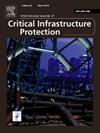Simulation of multi-stage attack and defense mechanisms in smart grids
IF 5.3
3区 工程技术
Q1 COMPUTER SCIENCE, INFORMATION SYSTEMS
International Journal of Critical Infrastructure Protection
Pub Date : 2024-12-05
DOI:10.1016/j.ijcip.2024.100727
引用次数: 0
Abstract
The power grid is a vital infrastructure in modern society, essential for ensuring public safety and welfare. As it increasingly relies on digital technologies for its operation, it becomes more vulnerable to sophisticated cyber threats. These threats, if successful, could disrupt the grid’s functionality, leading to severe consequences. To mitigate these risks, it is crucial to develop effective protective measures, such as intrusion detection systems and decision support systems, that can detect and respond to cyber attacks. Machine learning methods have shown great promise in this area, but their effectiveness is often limited by the scarcity of high-quality data, primarily due to confidentiality and access issues.
In response to this challenge, our work introduces an advanced simulation environment that replicates the power grid’s infrastructure and communication behavior. This environment enables the simulation of complex, multi-stage cyber attacks and defensive mechanisms, using attack trees to map the attacker’s steps and a game-theoretic approach to model the defender’s response strategies. The primary goal of this simulation framework is to generate a diverse range of realistic attack data that can be used to train machine learning algorithms for detecting and mitigating cyber attacks. Additionally, the environment supports the evaluation of new security technologies, including advanced decision support systems, by providing a controlled and flexible testing platform.
Our simulation environment is designed to be modular and scalable, supporting the integration of new use cases and attack scenarios without relying heavily on external components. It enables the entire process of scenario generation, data modeling, data point mapping, and power flow simulation, along with the depiction of communication traffic, in a coherent process chain. This ensures that all relevant data needed for cyber security investigations, including the interactions between attacker and defender, are captured under consistent conditions and constraints.
The simulation environment also includes a detailed modeling of communication protocols and grid operation management, providing insights into how attacks propagate through the network. The generated data are validated through laboratory tests, ensuring that the simulation reflects real-world conditions. These datasets are used to train machine learning models for intrusion detection and evaluate their performance, specifically focusing on how well they can detect complex attack patterns in power grid operations.
智能电网多阶段攻防机制仿真
电网是现代社会重要的基础设施,对保障公共安全和社会福利至关重要。随着它越来越依赖数字技术进行操作,它变得更容易受到复杂的网络威胁。这些威胁如果成功,可能会破坏电网的功能,导致严重的后果。为了减轻这些风险,开发有效的保护措施至关重要,例如可以检测和响应网络攻击的入侵检测系统和决策支持系统。机器学习方法在这一领域显示出巨大的前景,但它们的有效性往往受到高质量数据稀缺的限制,主要是由于保密性和访问问题。为了应对这一挑战,我们的工作引入了一种先进的模拟环境,可以复制电网的基础设施和通信行为。这种环境能够模拟复杂的、多阶段的网络攻击和防御机制,使用攻击树来映射攻击者的步骤,并使用博弈论方法来模拟防御者的响应策略。该模拟框架的主要目标是生成各种各样的真实攻击数据,这些数据可用于训练机器学习算法,以检测和减轻网络攻击。此外,该环境通过提供一个可控和灵活的测试平台,支持评估新的安全技术,包括先进的决策支持系统。我们的模拟环境被设计成模块化和可扩展的,支持新用例和攻击场景的集成,而不严重依赖外部组件。它支持场景生成、数据建模、数据点映射和功率流模拟的整个过程,以及通信流量的描述,在一个连贯的过程链中。这确保了在一致的条件和约束下捕获网络安全调查所需的所有相关数据,包括攻击者和防御者之间的交互。仿真环境还包括通信协议和网格操作管理的详细建模,提供了对攻击如何通过网络传播的见解。生成的数据通过实验室测试进行验证,确保模拟反映了现实世界的条件。这些数据集用于训练用于入侵检测的机器学习模型并评估其性能,特别关注它们在电网运行中检测复杂攻击模式的能力。
本文章由计算机程序翻译,如有差异,请以英文原文为准。
求助全文
约1分钟内获得全文
求助全文
来源期刊

International Journal of Critical Infrastructure Protection
COMPUTER SCIENCE, INFORMATION SYSTEMS-ENGINEERING, MULTIDISCIPLINARY
CiteScore
8.90
自引率
5.60%
发文量
46
审稿时长
>12 weeks
期刊介绍:
The International Journal of Critical Infrastructure Protection (IJCIP) was launched in 2008, with the primary aim of publishing scholarly papers of the highest quality in all areas of critical infrastructure protection. Of particular interest are articles that weave science, technology, law and policy to craft sophisticated yet practical solutions for securing assets in the various critical infrastructure sectors. These critical infrastructure sectors include: information technology, telecommunications, energy, banking and finance, transportation systems, chemicals, critical manufacturing, agriculture and food, defense industrial base, public health and health care, national monuments and icons, drinking water and water treatment systems, commercial facilities, dams, emergency services, nuclear reactors, materials and waste, postal and shipping, and government facilities. Protecting and ensuring the continuity of operation of critical infrastructure assets are vital to national security, public health and safety, economic vitality, and societal wellbeing.
The scope of the journal includes, but is not limited to:
1. Analysis of security challenges that are unique or common to the various infrastructure sectors.
2. Identification of core security principles and techniques that can be applied to critical infrastructure protection.
3. Elucidation of the dependencies and interdependencies existing between infrastructure sectors and techniques for mitigating the devastating effects of cascading failures.
4. Creation of sophisticated, yet practical, solutions, for critical infrastructure protection that involve mathematical, scientific and engineering techniques, economic and social science methods, and/or legal and public policy constructs.
 求助内容:
求助内容: 应助结果提醒方式:
应助结果提醒方式:


